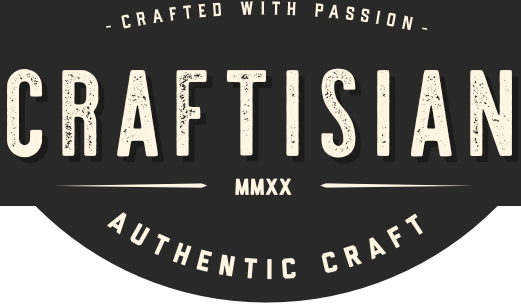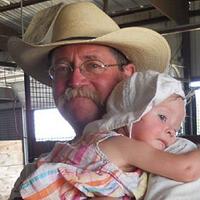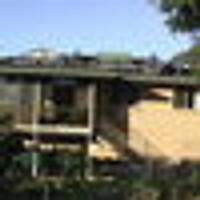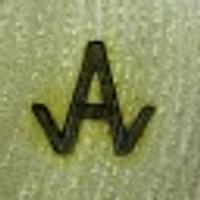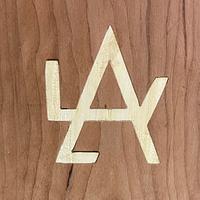
Lazyman
in about 3 years
Alphorn Experiment #3: Making the Straight Sections
This is
part 3
in a
5 part
series:
Alphorn Experiment
-
Making the Bell
-
Making the Straight Sections
-
Joining the Straight Sections
- Making the Bell
- Making the Straight Sections
- Joining the Straight Sections
Here you can see the beginning of the roughing toolpath on the first tile of the largest section. In the foreground you can see the alignment holes. There are 2 more 18" down the length and there are identical holes on the other side which make sure that it is positioned in the same place when I flip it over to machine the outside face. I later added additional holes to make the positioning more rigid as I moved the piece to machine the other end.
After finishing tile 1 on the inside, The workpiece is moved to machine the second tile.
Because of the thickness of the workpiece, my clamps are not tall enough to hold it down so work-holding was a little sketchy. Fortunately the dowels in the spoilboard help keep it in place laterally but I had to pause the machining from time to time to make sure that the screw clamps and hold downs were still tight. For subsequent sections, I used a combination plane to cut a groove into both long edges which made it easier and more secure to hold the work piece down.
After the inside, flip it over and do it again (this is actually the other half of the first section after I added clamping wings) .

I did not make a profile pass on this one to cut it out. The finishing toolpath left a paper thin layer that I could simply push a flush cut saw through to cut off the tabs.
Just holding the pieces together after freeing from the blank to make sure that they actually match. You can see I had some tearout on the end that I fixed before gluing the halves together.
Then it was just a matter of repeating the process 7 more times. Each half section probably took about 2.5 hours of setup and machining, not counting the prepping the blanks. Blank prep entailed ripping the 2x12s to width to match the thickness of the blank, planing, glue up, final planing to thickness and then cutting the grooves for the clamping wings
Before glue up I did some basic sanding to remove some of the tooling marks, mostly on the sides where the finishing pass is mostly cutting with the side of the bit. You can see some of that on the left side in the above image. On the 3 smaller sections, I decided to apply a light finish of Tried and true varnish oil to add a little spit resistance. I will have to figure out how to finish the inside of the largest section.
Clamping was again done with giant rubber bands but in later sections, I also added some clamps for a little extra hold. I used liquid hide glue to join the halves.
Once everything was glued up, I used a block plane to clean up the tabs and glue joints as well as some machining marks that were going to take too long to sand away. The shavings are from the 3 previous segments.
I then mounted each one on the lathe for sanding. The lathe was just a convenient platform for sanding. I did a little sanding with the lathe turning but I mostly just sanded lengthwise by hand I also squared up the rounded corners on the ends where coupling sleeves will go. I was a little afraid I would destroy them in the last step, though I may still have some later steps that could destroy a section. This is the smallest section just as the one above. I designed them so that they would just barely fit on my lathe (actually planned ahead for once). I was pleasantly surprised that they were mostly round when when I turned on the lathe.
All four segments and the bell smoothed and sanded.
BTW, when I was buying the last two 2x12s at Lowe's, I realized that this is actually Douglas Fir, not SYP. They have one stack of Douglas Fir right next too the SYP and because it looks so good is why I bought it thinking it was SYP. Other than 4x4s it has been years since I have seen Doug Fir down here. I did use one piece of SYP before I realized that the rest of the wood was DF, which stands out like a soar thumb on the bell.
Coming up next is figuring out how to actually join the segments in a way that they can be disassembled for transport and still strong enough to not break apart. I probably should have planned that out before now but I am still playing around with ideas.
--Nathan, TX. Hire the lazy man. He may not do as much work but that's because he will find a better way.
18 Comments
Looking fantastic Nathan, carry on and keep those clamps handy, seems to take one or two.
Looking good, Nathan.
May you have the day you deserve!
Funny you should say that, Dave. I had one section inside the other and tried to pull it out the wrong way and I had a thought for the "next one" I make. The way it slide part of the way out reminded me of a telescoping antenna.
--Nathan, TX. Hire the lazy man. He may not do as much work but that's because he will find a better way.
Petey
--Nathan, TX. Hire the lazy man. He may not do as much work but that's because he will find a better way.
The collapsing tube sounds trick, great way to blow your horn, collapse it down and sneak away before they call the Sheriff and have you brought in for being untoward.
About joining the parts, how about some type of latching mechanism, sort of like the ugly, but effective, way I fixed the broken latch on this case. Try to find something attractive though.
"Duck and Bob would be out doin some farming with funny hats on." chrisstef
You might be able to use that idea for joining yours.
They even sell carrying bags and mouth pieces.
"Duck and Bob would be out doin some farming with funny hats on." chrisstef
You could make some sleeves that the smaller ends of your segments could slide into for a friction fit.
One thing he mentioned is leaving the small end long and trim it as you tune the alphorn to F and explained it at the end.
"Duck and Bob would be out doin some farming with funny hats on." chrisstef
Latches like that are one of the options I am toying with. I've used some spring loaded ones in the past that I really like. They sort of take up any slack so you don't have to worry about it breaking the wood. Another option are box latches like this, though I would probably have to bend them to mount them on the curved surface

I've browsed many of the websites including Thomann looking at designs and ideas for joining the segments. Most of them seem to use aluminum or brass sleeves. I am currently working on a wood sleeve design that I can cut on my CNC, though it may require some work on the lathe too. My first thought for gaskets or sealing rings was to get some cork like is used to join segments of woodwind instruments but finding natural cork sheets in the sizes I need is difficult and expensive. I can find plenty of the cork like is used in bulletin boards but I am afraid it will be to crumbly and diffult to wrap around the tenon, especially the smaller ones. I am currently thinking about using crubber like they sell to line vice jaws and as gasket material
That last link was the website (Arbobuilder) that my friend who asked me to make this for him sent me. It may be what inspired him to ask in the first place. I actually used the measurements from that website to create my design. The guy's approach was to make 10' long tapered staves joined with a birds mouth -- like building a wooden mast. Other information on the site is about boats so that is no surprise. Since the staves are tapered that makes it a pretty complex thing to get right and still require significant shaping and carving after glue up. I considered that approach but while working through a segmented design, I came up with my CNC method.
--Nathan, TX. Hire the lazy man. He may not do as much work but that's because he will find a better way.
Regards Rob
"Duck and Bob would be out doin some farming with funny hats on." chrisstef
Coming up next is figuring out how to actually join the segments in a way that they can be disassembled for transport and still strong enough to not break apart.
Maybe an "O" ring on the tenon half of the joint? The rubber will compress and tighten the joint, a little lube every once in a while should keep it working. Just a thought...
That would require a groove to keep it in place.
There's roosters laying chickens,and chickens laying eggs... John Prine
I bought some small latches similar to what Duck showed above that I will add if necessary. With the length and weight that is very likely.
--Nathan, TX. Hire the lazy man. He may not do as much work but that's because he will find a better way.
There's roosters laying chickens,and chickens laying eggs... John Prine
--Nathan, TX. Hire the lazy man. He may not do as much work but that's because he will find a better way.








